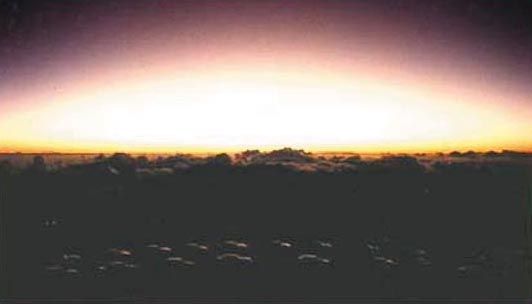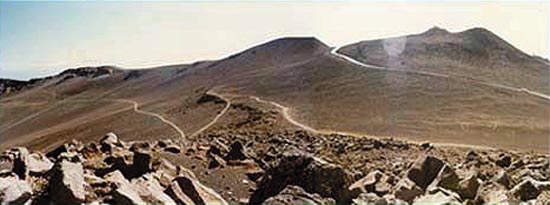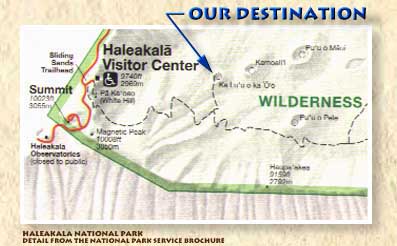|
Today, the trip to the House of the Sun takes a little more
than an hour, and hundreds of people daily shiver in the darkness, waiting for the first ribbon of color to appear
on the eastern horizon.
Then, an hour or so later, in the full light of a new day, most of them jump in their cars, or on a bicycle, and leave.
A few do not.

Cars line up along the road at the summit of Haleakala.
They hang around the summit for an hour or so, exploring the accessible reaches of Pu'u 'Ula'ula (Red Hill) and
Pa Ka'oao (White Hill) scampering over cinder and boulder, before they, too, depart.
Fewer still, are those that don't confine themselves to the summit of Haleakala. For, not far from the visitor
center at the 9800 foot level is the beginning of the Sliding Sands Trail, and a
quick descent into the sleeping giant. Sliding Sands Trail drops 2000 feet in only a mile of hiking, which makes
the descent rapid and incredibly easy and fun.
But beware! The ease of descent finds its perfect balance in the hike out, which will literally take your breath
away. You'll want to rest often on the way back out of the
crater, but that shouldn't stop you from going in. If you can walk around a shopping mall all afternoon, then you can
survive a day-hike in the world's largest dormant volcano, and you really
owe it to yourself to go. (Of course, there are other ways to see the crater, on a guided hiking tour, or by
horseback. Look in the yellow pages under "Tours" if you don't feel like exploring on your own.)
For you who choose to hike into Haleakala Crater on your own, it is important to remember that despite the apparent
ruggedness of the terrain, Haleakala is a fragile wilderness environment,
and the very presence of humans is disruptive to the balance of nature. You should always observe the greatest care
in order to preserve this precious wilderness.
A few simple, common sense rules will do:
- Do not leave the marked trails. Doing so can harm delicate seedlings, crush rare insects, and
contribute to erosion of the loose cinder. As you hike you will see where the footprints of others
have gone off the trail, spoiling what would have been the unmarked and undisturbed perfection of the cinder
scenery. Please don't contribute to this undesirable intrusion into the natural beauty. Stay on the marked trails.
- Do not bring your pet to hike with you. They can cause tremendous damage to the native wildlife, even more
so than ourselves, and we can be pretty bad.
- Do not leave any trash. Every bit of trash that remains in the crater is a disturbance to the environment.
Even cigarette butts are glaringly visible against the seamless perfection of the crater's beauty.
- Do not feed the nene, or other wildlife. The nene have become accustomed to our presence and will even come
up to you for food scraps. Human food is harmful to them, and it is your responsibility to not offer it.
- Do not remove rocks from the crater, or plants, or anything else. Do pick up trash you encounter, but don't
disturb anything else. You will hear that it is considered "bad luck" to remove rocks from Haleakala, and in the
Visitor Center on the crater's rim, you can read letters from people who encountered incredible bad luck, and
subsequently mailed their rocks back! Enough said, eh?
- Do not make any of those silly stacks of rocks that you may see. This is a Hawaiian place, and that is NOT
a Hawaiian tradition. It is inappropriate and disturbing to what should be a natural scene, unscarred by human
foolishness. It is a form of graffiti, and it should be stopped. Please, do not contribute to this silliness.
Now that you've taken care of protecting the crater, you should consider protecting yourself, too. The crater
weather is unpredictable. It can go from hot and sunny to cold and rainy in a moment. And at night you can be
certain that the temperature will be around freezing. No matter whether you read it in Fahrenheit or Celsius,
you'll be cold!
The elevation at the summit is 10,023 feet above sea level. The crater floor averages 6,700 feet. At these
altitudes,
the air is thin and the ultra-violet radiation is very strong. You should be prepared to protect yourself from sunburn
and sudden weather changes.
Wear extra clothing. You can always ditch it in the car after the sun comes up. I strongly recommend wearing a
pair of socks on your hands! Unless you came to Hawai'i with mittens you won't be prepared for freezing fingers.

In this photo taken near the trailhead, Sliding Sands Trail arcs into the distance
as it descends into Haleakala Crater.
The descent begins, as was said, at the 9780' trail head and runs in a gentle curve along the southwestern inside
wall of the crater. A couple of times it switches back on itself for a few hundred yards before continuing its
sweeping arch down to the crater floor at about 7000' elevation.
After only 1 and 1/2 miles, the trail splits in two directions. The path to the right leads east across the
crater, passing Kapalaoa cabin, eventually reaching Paliku cabin, some miles distant. The trail to the left
takes you less than a mile to the north, to Ka Lu'u o Ka 'O'o, a silent cinder cone, close to the western end
of the crater. This is the trail to take, a brief but rewarding excursion, as you'll soon discover.
The trail to Ka Lu'u o Ka 'O'o runs along a ridge extending into the crater from the southwestern corner. It
winds around boulders and through a thriving patch of silversword plants. If you're lucky, several of the mature
silverswords will be in bloom, their tall spike of raspberry scented blossoms reaching for the abundant sunlight.
If none are in bloom, the silverswords are still a marvel, with their fuzzy silver blades spread perfectly about
the hidden stem within.
A relative of the sunflower (look at the individual flowers and you'll notice the family resemblance,) the
silversword is unique to the Hawaiian islands, growing only here in Haleakala, and on the high slopes of Mauna Kea
and Mauna Loa on the Big Island. Protected both by law and conscience, the silversword has proliferated in the last
ten to fifteen years. The first time I hiked in Haleakala I saw only one small silversword, and it was not in bloom.
You can see, when you hike, that the situation has greatly improved over time, and this truly rare plant now appears in abundance.
Hiking in Haleakala Crater is, in itself, a stunning experience. If you're alone, or in a small group, and you all
stop and stand still, silently holding your breath, you hear one of the rarest of sounds. . .the coursing of the
blood in the capillaries of your eardrums. . .the sound of silence!
You might occasionally hear the honk of a nene, the rare and endangered native Hawaiian goose, which like the
silversword, is only found here and on the Big Island. But, it is more likely that you will not. Sorry.
The experience of hiking in the crater certainly defies description. How do you communicate the crunching of the
glassy cinder underfoot, or describe the perfect smoothness of the cinder landscape, all gray in one place, but
speckled with randomly distributed red rocks spread in every direction. You walk along and then, suddenly, it
all switches. The cinder is red everywhere, and the speckles are black. And then a swath of yellow cinder cuts
across the land. You just have to see it for yourself.
Distances are very difficult to judge in Haleakala Crater. What seems a long way off is often remarkably close,
and what seems to be "just over there", can take a good while to reach. Often what appears to be rocks nearby,
are great boulders by the time you get to them.
It will only take an hour or so for you to reach Ka Lu'u o ka 'O'o, and it is a good idea to take a nice long
break before doubling back. If you brought snacks, eat them, but be sure to pack out your trash.
After you're rested, you can begin the trek back to the summit. I wouldn't be exaggerating if I told you it
can be very tiring. Don't hesitate to stop and catch your breath. The return trip is almost a constant ascent
through increasingly thinner air, so oxygen is scarce, and you shouldn't push yourself too hard. Take it nice
and slow, and you'll still get to the top, and you won't feel like you're dead when you get there.
CLICK FOR A VRML PANORAMA

The hike out will take you much longer than the hike in. It can take a somewhat more than two hours at a leisurely
pace, WHICH IS THE PACE YOU SHOULD TAKE.
None-the-less, at that pace you will arrive back at the summit by noon, and have plenty of time left in the day
for relaxing at the beach. So, take your time. Don't feel rushed. Enjoy the spectacular views on all sides. You
won't even notice the effort, and by the time you return to the Sliding Sands Trailhead, you'll be able to turn
around and look back on Haleakala Crater, and feel within you the deeper connection that you have made with this
special paradise, Maui.
Aloha!

|

